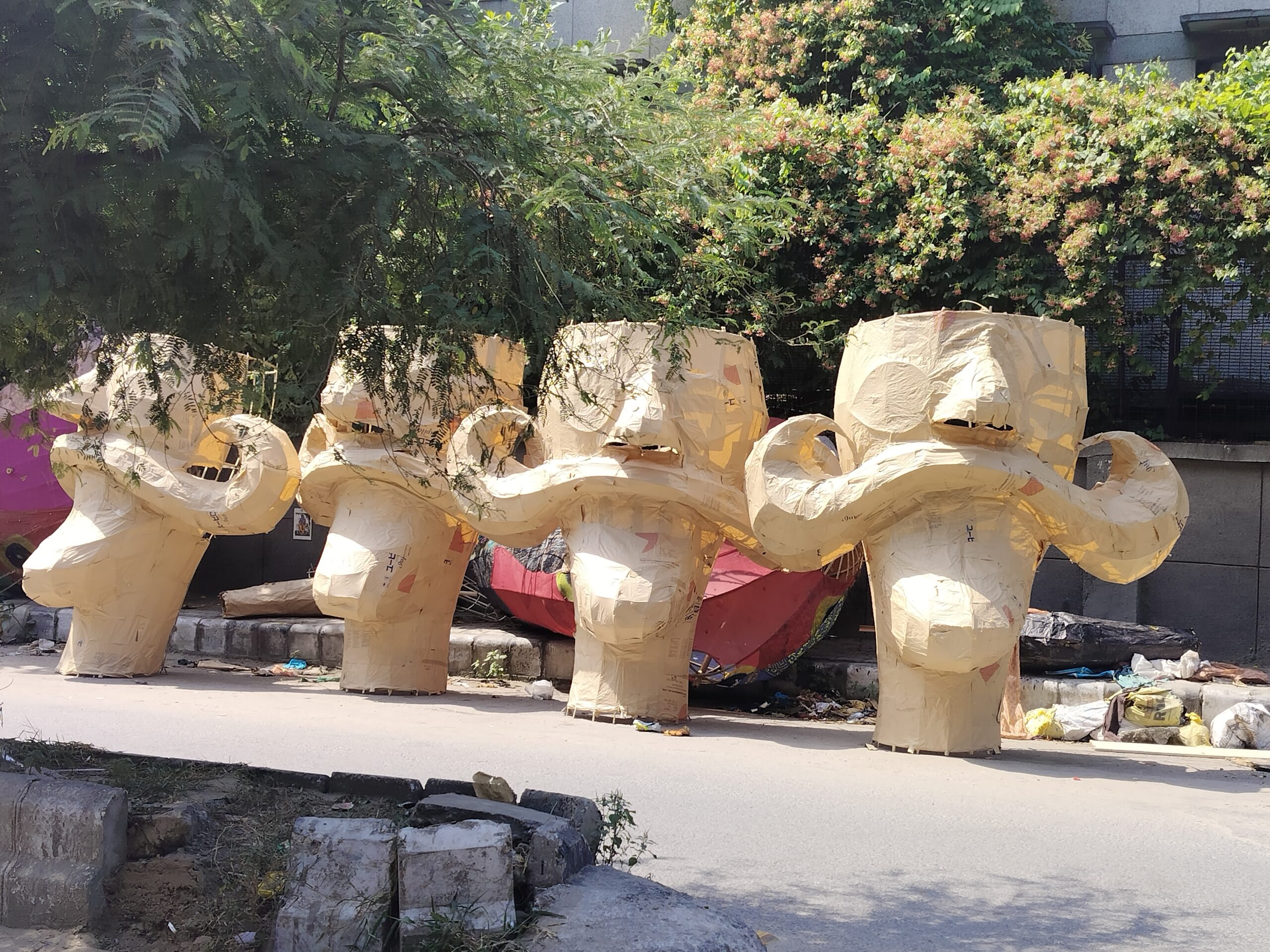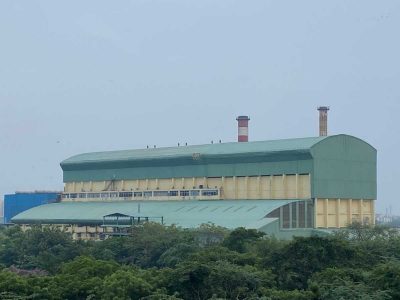Titarpur, lying between the neighbourhoods of Subhash Nagar and Tagore Garden, is bustling with activity ahead of Dussehra. This vibrant urban village is Asia’s largest effigy market and can aptly be called the “Ravana Supermarket”.
As you meander through this lively enclave’s streets, you’ll encounter an array of meticulously crafted bamboo body parts representing Ravana and his brothers.
It is as if this is the place where the demon king is reborn every year.
With a keen interest in the artistry of these effigy-makers, the demand for their creations, and the state of their sales, we speak to Sonu, a trader of Ravana effigies.
“Inflation has emerged as a major concern this year, with the price of bamboo soaring from a modest 40 rupees per quintal [last year] to a staggering 800 rupees per quintal. Consequently, our effigies, once priced at 600 rupees per foot, will now reflect the economic realities and be offered at 800 rupees per foot,” he says.
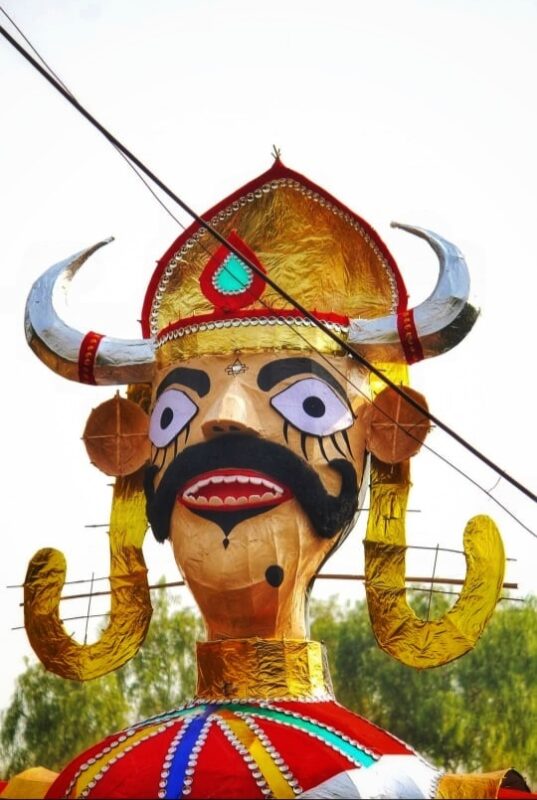
Artisan Prakash Jha, with three decades’ experience of crafting Ravana effigies, mentions that the production cost has increased significantly this year compared to last year.
“This is due to the higher prices of materials like paper and bamboo, as well as the need to incorporate eco-friendly crackers to reduce pollution. These factors collectively contribute to the rising costs. To mitigate this, many Ramleela committees have chosen to reduce the size of their effigies. In the past, private housing societies used to commission Ravana effigies towering 15-20 feet. However, this year, they are opting for smaller 5 to 10-feet Ravana effigies. There’s also a decline in orders for effigies of Kumbhakarna and Meghnad this year,” shares Jha.
The family legacy
Titarpur awakens with fervour as the auspicious season approaches. The streets teem with life, as artisans toil to craft these larger-than-life embodiments of evil. Each stroke of their skilled hands resonates with the cultural significance of Dussehra, celebrating the timeless tale of Rama’s triumph over the malevolent Ravana, as mentioned in the verses of the Ramayana.
Tourists and locals alike visit Titarpur, drawn by the allure of witnessing art in its purest form. The effigy makers’ humble abodes transform into open-air galleries, where the process unfolds with precision and grace.
Yet, Titarpur is more than just a bastion of culture; it’s an economic lifeline for the artisans. Their craftsmanship not only preserves heritage but also fuels the local economy, marking a balance between tradition and livelihood.
“We start sculpting the demon king’s curly mustaches, broad lips, and bulging eyes shortly after Rakshabandhan in August. Since everything is hand-crafted, it takes a lot of time,” says Bhanu Pratap, 55, a third-generation Ravana-maker.
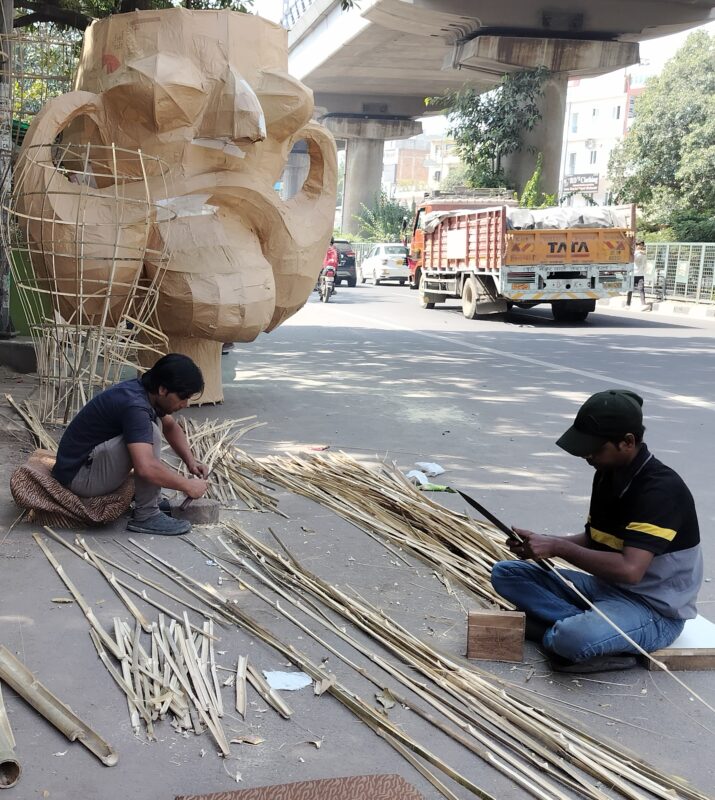
Next to him, his 52-year-old wife Rajni is using a long spoon to mix the ingredients in a pot placed over an open flame, to create “GlimmerGoo” — a sticky, translucent adhesive made from a blend of flour, tapioca starch, and water. This comes in handy when attaching vibrant coloured sheets onto the figurines. Rajni’s seven-year-old son is also helping his parents in the process.
“Our Dussehra effigies were sought after in Uttar Pradesh, Haryana, Rajasthan, Madhya Pradesh, and even overseas,” states Rajni proudly.
“But things are very different after Covid. We now struggle to get big orders. People have changed their idea of celebration now. They no longer stress on the grandeur. Gradually, orders declined and now we are struggling to make ends meet,” says Rajni.
Labour cost is higher than ever
The labour force in post-pandemic India has faced various challenges and changes.
“Covid-19 pandemic had a significant impact. Lockdowns and restrictions led to job losses, reduced income, and economic uncertainty for many workers, particularly in the informal sector,” says Rekha Sharma, a teacher of economics at a government school.
A large portion of India’s labour force operates in the informal sector, which lacks job security and social protections. The pandemic and lockdowns highlighted the vulnerabilities of migrant labourers.
During the festive season leading up to Dussehra, more than 3,000 skilled artisans gather in Titarpur, with many of them hailing from Uttar Pradesh, Gujarat, Rajasthan and Bihar.
Ramgopal Choudhary, 44, one of the migrant workers, explains, “I work tirelessly in 10-hour shifts. It is not easy to mould the bamboo and give it shape. It requires focus and strength. At a time when everything is expensive — from vegetables to essential oils and milk — it is difficult to survive. Therefore, the labour cost has increased drastically.”
Pankaj Kumar, 60, who runs a workshop in Titarpur, says, “The labour that used to work for about Rs 15,000 per month is now working for Rs 20,000. Everything is costly now. It is important to note that there’s no use of technology or machine as such. We are totally dependent on labour. Therefore, the rising labour cost is forcing us to produce limited number of effigies this year.”
Kumar explains that people from Rajasthan and Bihar also join in to install fireworks within the effigies besides assembling them. However, the ban on firecrackers for the last couple of years has left a significant part of the labour jobless.
High cost, less production
‘Mahendra and Subhash Ravan Wale’ is located near the Tagore Garden Metro Station. It is a bright morning but nothing is bright for Raja, the owner of the workshop claiming to be the oldest Ravana effigy-maker in the region.
Raja says, “We will be making less effigies this year because we don’t want to take any chance. The sight of members from the festival committee organising Ramleelas and melas strolling through the streets of Titarpur, their safari suits full of bulging wads of cash, appears like a thing of past.”
He adds that there is no craze for effigies nowadays.
“For people, the festival is still the same as they can spot the effigy on TV or somewhere else. However, for us it is never going to be the same.”
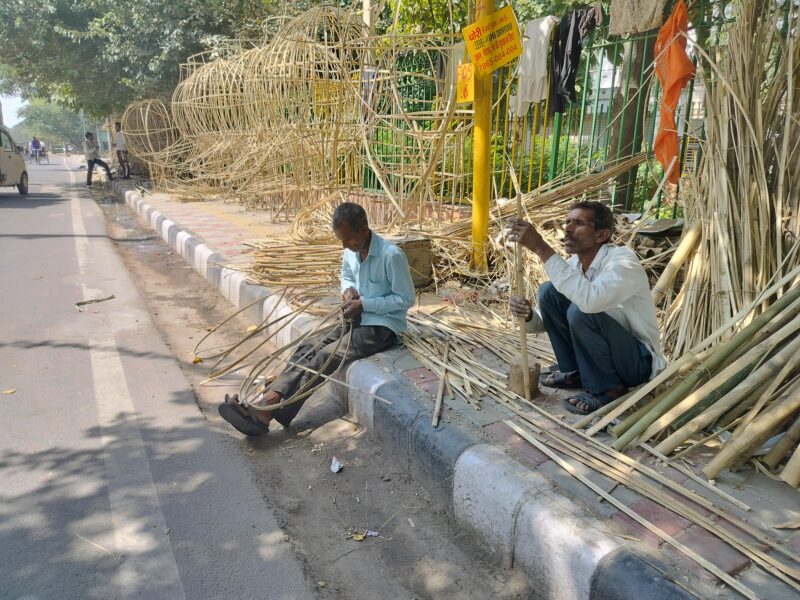
He highlights that increased environmental awareness indeed leads to concerns about activities like burning effigies, which can contribute to air pollution and waste generation. This realisation often leads to a reduced demand for effigies as people seek more environmentally friendly alternatives.
Agreeing with Raja, Siju Kumar, another artisan, says, “There is no fun without crackers. What do people look up to every Dussehra? They enjoy the bursting of crackers and the pomp and grandeur of the festival. So, the ban on crackers is obviously affecting the demand.”
The 30-year-old adds that even big housing societies are no longer ordering effigies.
“We have decided to make a limited number of effigies. I have just sent four effigies to Haryana and one to Sangam Vihar. But it is nothing like earlier times when we used to make thousands of effigies and even a day before the Dussehra we would be hastening to finish one last order.”
Sixty-year-old Ram Lal, another artisan, says, “I charge about Rs 3,000 to Rs 12,000 for an effigy depending on the size. This year, I have already sold 20 effigies to different people across the country.”
The artisans are also forced to make limited effigies because these effigies are of no use after the festival.
“Till five years ago, if effigies were not sold out then we would simply burn them [since we would have recovered the investment]. But now taking such a risk is too much,” explains Shyam, 35.
Since this is a seasonal work, most of them work on something else throughout the year like decorators in weddings, events or parties.
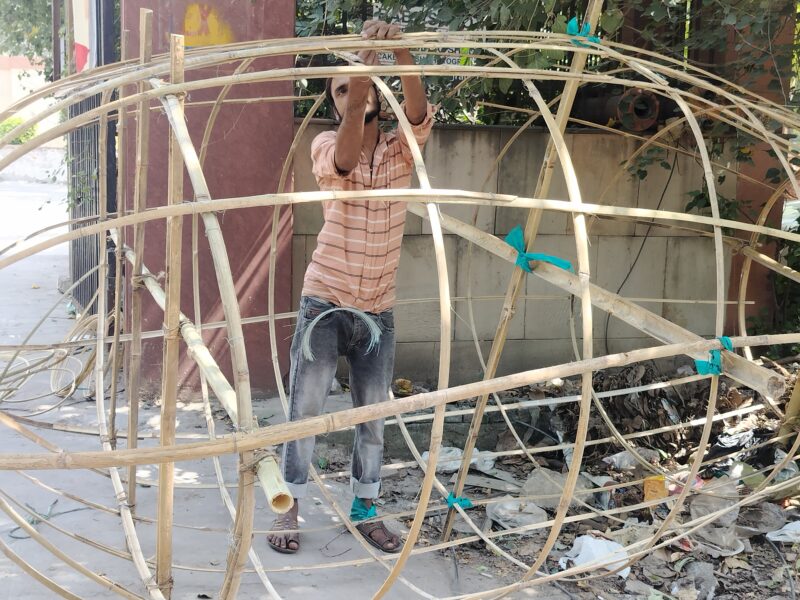
“We don’t want to invest our time in making surplus effigies only to see them lying on the ground waiting for the buyers. We really don’t have enough buyers,”.
The way forward
The demand for effigies has reduced to 40% of what it was a few years ago.
Consequently, a prevailing trend among artisans is the deliberate restraint in the creation of effigies.
Once a family legacy, it is now a means of survival for the artisans. The young generation is aspiring to study and move out of Titarpur.
“My nine-year old is always fascinated by the effigies but he never wishes to enter the profession because he knows it has no future. This is because of the informal setting of this occupation and cultural shift. I too want my child to take up a different skill and earn good money,” says Dalip Chauhan, 67.
Kapil Singh, 22, who always accompanies his father to different grounds in order to help him set up the effigies on Dussehra, has never thought of carrying this legacy forward.
He shares, “People are so scared of pollution that I fear the government might ban the burning of effigies.”
He says that that there is a lot of financial insecurity in the business.
“The raw material is expensive and on top of that we are not provided any security.”

